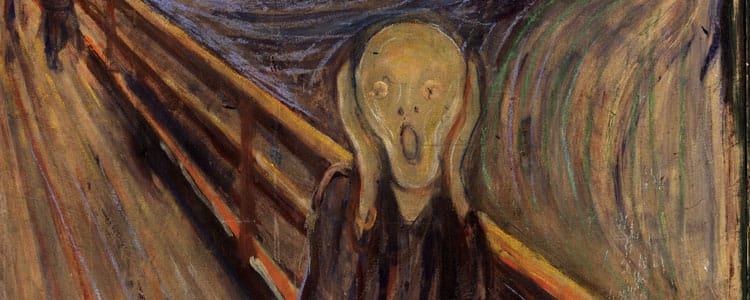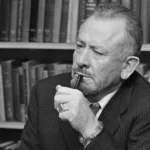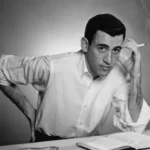Get ready to embark on a fascinating exploration of Edvard Munch, the artist who gave us the haunting “The Scream.” We’ll delve into his intriguing life, from his early inspirations to his battles with mental health. Discover the enigmatic mind behind this Expressionist masterpiece and the story of the troubled soul whose pain fueled his artistic brilliance.
Interesting Facts About Edvard Munch
Ever heard of Edvard Munch? You’ve probably seen his most famous painting, “The Scream” – you know, the one with the person holding their face and looking super stressed out? Yeah, that’s Munch’s masterpiece. But there’s a lot more to this guy than just one painting. Let’s dive into some interesting facts about the man behind the art:
Munch: More Than Just an Expressionist
People often label Munch as an Expressionist painter. While that’s partly true, he was way more diverse than that. He dabbled in symbolism – using objects to represent ideas – and even flirted with abstract art, where things aren’t always super realistic. He wasn’t afraid to mix things up and create his own unique style.
Life’s a Rollercoaster: Exploring the Human Condition
Munch’s art wasn’t just about pretty landscapes; he went deep, exploring the raw, emotional stuff that makes us human. Think about it: anxiety, feeling alone, the ups and downs of love, and even death. Munch wasn’t afraid to tackle them head-on, and you can feel the rawness and intensity in his paintings.
A Troubled Mind: The Influence of Mental Illness
It’s no secret that Munch struggled with his mental health. Some experts believe this played a huge role in his art, giving it that haunting, sometimes unsettling vibe. His paintings often feel like a window into a troubled mind, which makes them all the more captivating.
Did you know?
Now, let’s get to the good stuff – those intriguing tidbits that make you go, “Wait, really?”
- Outdoor Art Gallery? Munch was known to store his paintings outdoors! Talk about unconventional! This definitely added to the mysterious aura surrounding his work, but it also makes you wonder about the impact on the art itself. Preservation probably wasn’t top of mind!
- The Cell Phone Visionary: Get this – Munch actually envisioned the concept of the cell phone way before it became a thing! He even sketched it out! This shows that he wasn’t just an artist; he was a forward-thinker, a visionary who saw beyond the canvas.
- Food for Thought: Munch was a vegetarian and later switched to pescatarianism. Could his diet have influenced his art? It’s definitely possible! Some experts believe that what we eat can impact our creativity and perspective. Who knows, maybe those veggies fueled his artistic genius!
The Scream: A Glimpse into Existential Angst
We can’t talk about Munch without mentioning his most iconic creation, “The Scream.” This painting perfectly captures that feeling of overwhelming anxiety and existential dread that we’ve all probably felt at some point in our lives. The swirling colors, distorted figure – it’s both unsettling and strangely relatable.
More Intriguing Nuggets:
- The Enigma of Outdoor Storage: Munch’s habit of leaving his paintings outside raises a lot of questions about art preservation and the artist’s intention. Was he deliberately letting nature leave its mark, or was it simply a matter of convenience? We may never know for sure, but it adds another layer of intrigue to his already fascinating story.
- A Peek into the Future: Munch’s “invention” of the cell phone idea goes beyond just being a cool fact. It suggests a mind that was constantly thinking, observing, and imagining possibilities outside the realm of traditional art. This willingness to think differently is likely what made him such a groundbreaking artist.
- Food and Philosophy: Munch’s dietary choices provide a glimpse into his personal beliefs and lifestyle. While we can’t definitively say that vegetarianism directly influenced his art, it’s interesting to consider how our choices and values might shape our creative output.
The Mystery Continues:
There’s still so much we don’t know about Edvard Munch and the motivations behind his extraordinary art. But that’s what makes him so captivating. He was a complex individual who poured his soul onto the canvas, leaving us with more questions than answers. So, the next time you see one of Munch’s paintings, remember that there’s a whole lot more going on beneath the surface, waiting to be explored.
What are 5 Interesting Facts About Edvard Munch?
Let’s dive deeper into the fascinating world of Edvard Munch. His paintings are like windows into the human soul, full of raw emotion and powerful symbolism. But who was the man behind those iconic images? Let’s uncover some intriguing facts about his life and work.
1. A Childhood Marked by Loss
Edvard Munch grew up in Norway, where tragedy struck his family early on. Tuberculosis claimed the life of his mother, and years later, his beloved sister, Sophie, succumbed to the same disease. These experiences left a deep scar on Munch’s heart and profoundly influenced his art. It’s likely no coincidence that themes of death, illness, and the fragility of life appear again and again in his work. He seemed to be grappling with these heavy emotions on his canvases.
2. The Allure of Paris
Like many aspiring artists of his time, Munch felt the pull of Paris, the art capital of the world. He traveled there to study and soak up the vibrant art scene. It was during this time that he encountered the revolutionary styles of Impressionism and Post-Impressionism. Artists like Monet and Van Gogh, with their bold colors and expressive brushwork, likely made a big impression on him. You can see their influence in the way Munch moved away from traditional, realistic painting towards a more emotionally charged style.
3. The Many Faces of “The Scream”
Have you ever wondered why there are multiple versions of Edvard Munch’s most famous painting, “The Scream”? It’s true! Munch wasn’t content with just one rendition of this iconic image of existential angst. He actually created four different versions! Each one has slight variations in color, composition, and the intensity of the screaming figure. It’s as if he was exploring the different facets of anxiety and despair, trying to capture the feeling in its entirety.
4. From Criticism to Acclaim
Munch’s art wasn’t always met with open arms. In fact, his unconventional style and unsettling subject matter initially provoked quite a bit of controversy. Critics in the late 19th century often dismissed his work as ugly or disturbing. However, as time passed and artistic tastes evolved, people began to recognize the power and emotional depth of Munch’s paintings. By the 1890s, he was gaining recognition through exhibitions in Germany and Norway, solidifying his place as a major figure in the art world.
5. Speaking a Universal Language
Perhaps the most remarkable thing about Edvard Munch’s art is its enduring ability to connect with people from all walks of life. His paintings delve into universal human experiences: love, loss, loneliness, fear, and the search for meaning. Even though they were created over a century ago, they still resonate deeply with audiences today. We can all relate to the raw emotions depicted in his work, reminding us that we are not alone in our struggles.
It’s important to note that our understanding of Edvard Munch and his art is constantly evolving as new research emerges. So, keep exploring and discovering more about this fascinating artist!
Did Edvard Munch Have a Pet?
Munch was a big-time dog lover. He believed that dogs had an ancient wisdom about them, a deep understanding of human emotions. Throughout his life, and especially after he moved back to Norway in 1909, Munch always had multiple dogs by his side. They were his buddies, his confidants, offering comfort and companionship, especially when he was struggling with his mental health.
Munch wasn’t always financially stable. He loved his dogs though, so much so that he’d sometimes offer his artwork as payment for things like meals or other expenses. It really shows you how important his dogs were to him.
You can’t talk about Munch without mentioning that famous self-portrait he painted in 1892, the one with the swirling colors and kinda spooky figures. You can almost feel the anguish radiating from it.
Munch wasn’t always the most careful when it came to looking after his artwork. That, combined with his love for his four-legged friends, means that some of his paintings actually have “special markings” from his dogs. These little accidents have actually become a unique part of his work, adding to the whole mystique and intrigue surrounding Munch and his art. It’s like a little piece of his life, his love for his dogs, accidentally imprinted on his paintings.
Want to learn more about Edvard Munch’s fascinating life and art? Check out this link:
Edvard Munch: Biography, Paintings, & Legacy
When did Edvard Munch Shoot His Finger Off?
We don’t know the exact day Edvard Munch accidentally shot his own finger. What we do know is that it happened because of a lover’s quarrel. Drama seemed to follow Munch around, especially when it came to romance. We can only speculate about the details of that night, but the incident definitely adds a whole other layer to the story of this already fascinating artist.
Munch wasn’t always kind to his artwork. Naturally, they ended up with all sorts of bumps and bruises – footprints, scratches, maybe even a paw print or two. It’s like he almost wanted them to experience life’s little mishaps right along with him.
For someone who pushed the boundaries of art, he really wasn’t a fan of photography. Munch thought photographs just couldn’t capture the raw emotion that a painting could. He saw photography as a bit superficial, unable to dive into the depths of human feeling like his brushstrokes could.
To really get inside Munch’s head, you have to read his personal writings. They paint a picture (pun intended) of a pretty eccentric guy. Someone deeply intrigued by the afterlife and, honestly, not too fond of his fellow artists.
Think about it: a guy who accidentally shoots himself in a love spat, leaves his paintings out in the elements, and snubs photography while pondering the great beyond. That’s Edvard Munch for you – a tangle of contradictions and complexities, just like his art.
What are Three Facts About The Scream Painting?
“The Scream” is even more interesting than you might think. For starters, did you know there isn’t just one “The Scream”? It’s actually a series of four versions created by Edvard Munch! And that bloodcurdling scream everyone knows? That’s not exactly someone yelling. It’s more like Munch trying to visually express this deep sense of anxiety and existential dread he was feeling.
Another thing that makes “The Scream” super cool is how deeply Munch connected with nature. He wasn’t just painting pretty scenery; he was pouring his own emotions and fears about the world changing around him right onto the canvas. It’s like Munch is saying, “Hey, the world can be a pretty intense place, and sometimes it makes me want to scream!”
Want to dive deeper into the mystery of “The Scream”? There’s a ton of info out there about its history and different interpretations.
What are Some Facts About Edvard Munch’s Childhood?
Edvard Munch, the artist behind the iconic painting “The Scream,” didn’t have the easiest childhood. Let’s take a closer look at his early years and how they might have shaped his unique artistic vision.
1. A Sickly Child Who Found Solace in Art
Munch was a sickly kid, often kept home from school due to bouts of illness, including tuberculosis, which ran in his family. All that time at home gave him a chance to draw. It became his refuge, a way to process his feelings and experiences.
2. The Shadow of Loss
Sadly, tragedy struck Munch’s family more than once. He lost his mother and a sister, Sophie, to tuberculosis when he was quite young. These weren’t just passing events; they left a deep and lasting impact on him. It’s not hard to see how these profound losses might have contributed to the themes of grief, anxiety, and isolation that permeate his work.
3. From Impressionism to His Own Unique Style
Early on, Munch was drawn to the vibrant colors and loose brushstrokes of Impressionism. But he wasn’t content to simply imitate. He eventually developed his own distinct style – one that was raw, emotionally charged, and often unsettling. Think swirling lines, bold colors that almost jump off the canvas, and figures that seem to express deep psychological turmoil.
Ongoing Research and Interpretations
While we can draw connections between Munch’s childhood and his art, it’s important to remember that interpreting art is not an exact science. Art historians continue to explore Munch’s life and work, looking for deeper meanings and influences. Some experts believe that Munch’s childhood experiences with illness and loss contributed to his fascination with themes of mortality and the fragility of life.
What is Edvard Munch Most Known For?
You’re probably already familiar with Edvard Munch, even if you don’t recognize the name right away. This Norwegian artist is the creative mind behind the instantly recognizable painting “The Scream.” But Munch was so much more than just that one painting, prolific in his artistic output and fascinating in the emotions he explored.
Beyond “The Scream”: A Peek into Munch’s Artistic World
While “The Scream” might be his biggest claim to fame, Munch didn’t shy away from digging deep into other subjects, using various art techniques to create a collection that truly reflects his own thoughts and feelings. Let’s delve a bit deeper into what made Munch’s art so unique:
1. A Window into the Mind: Art as Therapy
Munch wasn’t afraid to let his art be a reflection of his own struggles. He faced some tough times dealing with mental illness – things like deep sadness and constant worry. Rather than hiding these emotions, he poured them into his artwork. It’s this honesty that makes his work resonate so strongly with people, even today.
2. Breaking the Mold: Color and Emotion Collide
Back in Munch’s time, art had a certain look, a certain set of rules. Munch wasn’t afraid to toss those rules out the window. He embraced vibrant, even jarring colors, played with distorted shapes, and filled his paintings with symbols that held deeper meanings. His brushstrokes were bold and expressive, almost like they were fueled by the same emotional turmoil that was swirling around in his mind, and in the world around him.
3. Reading Between the Lines: Deciphering the Symbols
Munch loved to use symbols in his work. Think of them like little visual clues that hint at bigger emotions and ideas. Take the screaming figure – it pops up again and again in different forms throughout his art, exploring themes of life, death, love, and the pain of loss. Even his landscapes weren’t just pretty pictures; they were reflections of his own internal state, mirroring the ups and downs of being human.
4. Nature’s Mirror: Finding Solace and Turmoil
Speaking of landscapes, nature was a huge inspiration for Munch. He seemed to understand that nature could be both beautiful and terrifying, a source of peace and a reflection of inner turmoil. In his paintings, trees bend and twist, skies swirl with color, and landscapes become a way for him to express the full spectrum of human emotion.
5. A Lasting Impact: Paving the Way for Expressionism
Munch is considered a trailblazer in the art world, especially when it comes to a movement called Expressionism. This style of art was all about letting go of perfect representations and embracing the rawness of human emotion. Munch, with his bold choices and honest portrayals, helped pave the way for other artists to explore this style, leaving an undeniable mark on modern art as a whole.
Unraveling the Mystery: There’s Always More to Discover
One of the most captivating things about Edvard Munch is that while we can analyze his work and offer interpretations, there’s always an element of mystery. What was he truly feeling when he created these pieces? What did those symbols really signify to him? It’s like a puzzle that invites us to look closer, to think deeper, and to connect with the raw emotions that continue to resonate through his art.
What Did Edvard Munch Suffer With?
Edvard Munch’s life was full of difficult experiences that likely played a big part in shaping his art. He grew up surrounded by illness. He lost his mom and sister to tuberculosis, and his relationship with his dad was pretty strained. You can see how these early encounters with loss and difficult family dynamics would leave a mark on anyone.
It seems likely that Munch struggled with his mental health too. He dealt with things like depression and anxiety throughout his life. It’s not hard to see how those feelings of inner turmoil and darkness show up in his paintings.
Munch found ways to channel his experiences into his art, becoming a key figure in the Expressionist movement. He wasn’t afraid to break the mold, using bold colors, twisting shapes, and really diving deep into personal themes.
Love was another rollercoaster for him. He had his fair share of passionate but often chaotic relationships. These relationships, with all their ups and downs, definitely fueled his exploration of love, desire, and heartbreak in his work.
Even with his incredible talent, life as an artist wasn’t always easy. Munch faced financial struggles for a good chunk of his life. But his work started getting the recognition it deserved, making him a true pioneer in the art world.
What are the 4 Versions of The Scream by Edvard Munch?
Munch didn’t just create one version of his iconic image “The Scream.” There are actually four separate pieces by Munch that we call “The Scream”!
Think of it like your favorite song. There’s probably the original studio version, maybe a live recording, and perhaps even a remix or acoustic version floating around. Each one is recognizable as that song, but they all offer a slightly different experience.
That’s kind of how it is with The Scream. Munch seemed drawn back to this powerful image, exploring it in different ways throughout his career. Let’s break it down:
1. The Scream (1893) – The OG
This is the big one, the one you picture when you think of The Scream. It’s currently hanging out in the National Gallery of Norway. The vibrant colors and swirling brushstrokes really capture that feeling of existential dread.
2. The Scream (1895) – The Pastel One
Two years later, Munch revisited the theme, this time using pastels. This version, housed in the Munch Museum, is smaller than its oil-painted siblings. What’s interesting about this one is that it feels a bit more intimate, and the colors, while still intense, have a softer quality.
3. The Scream (1910) – The Bold Remake
Imagine a movie studio remaking a classic film. It’s basically the same story, but with a bigger budget and some modern twists. That’s kind of what’s going on with this version of The Scream, also in the National Gallery of Norway. It’s larger than the 1893 version and the colors are even bolder.
4. The Scream (1895) – The Lithograph
This one’s a bit different. Instead of a painting or drawing, it’s a lithograph, which is a type of printmaking. What’s fascinating about this is that it wasn’t actually created directly by Munch’s hand – he made the original design, but then it was reproduced. This is likely why this version is less talked about, currently residing in a private collection.
Why so many screams?
You might be wondering why Munch felt the need to create multiple versions of The Scream. Well, we can’t get inside his head, but some art historians suggest it was a way for him to work through intense emotions and anxieties. Each version might reflect a different stage in his own personal journey.
The Scream: More Than Just a Painting
What’s truly remarkable is how The Scream, in all its versions, has transcended its identity as “just a painting.” It’s become a cultural phenomenon, instantly recognizable and endlessly referenced. From parodies to merchandise, it’s safe to say The Scream has secured its place in the history of art and beyond.
How Many Paintings Has Edvard Munch Made?
While nailing down an exact number is tricky, experts believe Munch likely produced around 1,100 paintings during his lifetime.
It’s important to remember that this number isn’t set in stone. Art historians are always researching and uncovering new information, so it’s possible that more of Munch’s paintings are out there, just waiting to be discovered.
Think about it – sometimes, paintings get tucked away in private collections or misattributed to other artists. It’s like a giant art historical puzzle, and every now and then, a new piece falls into place!
What are Some Facts About Edvard Munch for Kids?
Edvard Munch is the guy behind the famous painting “The Scream.” But there’s a lot more to him than just that one masterpiece.
A Life Shaped by Loss
Edvard was born in Norway in 1863. He experienced the heartbreaking loss of several siblings and his mother to illness. These tragic events cast a long shadow over his life and deeply influenced his artistic vision. You can almost see those feelings of sadness and the idea of death popping up in his paintings.
Beyond the Brushstrokes
Edvard’s art wasn’t just about splashing paint on a canvas. He was a deep thinker, exploring big themes like love, life, and all the tricky emotions that come with being human. His paintings are like windows into his mind, showing us how he dealt with anxiety and the struggles we all face.
From Paris to “The Scream”
Interestingly, Edvard’s artistic journey took him to Paris for a bit. There, he was around Impressionist painters, which probably rubbed off on his own style. But Edvard wasn’t content with just copying others. He developed his own unique way of painting, using bold colors and bending shapes to make you feel something. And that brings us to his most famous work…
“The Scream,” painted in 1893, is like a visual representation of anxiety. It’s that feeling you get when you’re super stressed or scared. The distorted figure with the wide-open mouth, against a backdrop that seems to swirl – it’s both unsettling and captivating.
More Than Just “The Scream”
While “The Scream” is Edvard’s claim to fame, he was a painting machine, creating over 1,100 works of art during his lifetime. One famous series he did is called “The Frieze of Life,” and it’s like a visual storybook of human experiences, from the day we’re born to the day we die.
A Lasting Impression
Edvard Munch’s impact on the art world is undeniable. He’s considered a pioneer of Expressionism, an art movement all about expressing emotions in raw and powerful ways. Even though he passed away in 1944, his art continues to speak to people all over the world. You can find his works in museums and galleries globally. They’re a reminder that our feelings and experiences are timeless and universal.
Did you know that interesting facts about Barbara McClintock was an American scientist who was awarded the Nobel Prize in Physiology or Medicine in 1983 for her discovery of transposons? Or that interesting facts about Frederic Chopin was a Polish composer and pianist who is considered one of the greatest composers of the Romantic period? And did you know that interesting facts about JD Salinger was an American writer known for his novel The Catcher in the Rye?
- Unveiling the Enigma: Mansoureh Khojasteh Bagherzadeh’s Public Appearances & Private Life in Iran - July 18, 2025
- Unveiling the Mystery: Mansoureh Khojasteh Bagherzadeh’s Husband: A Rare Glimpse into a Private Life - July 18, 2025
- Unveiling Masoud Khamenei’s Mother: Power, Influence, and Iran’s Future - July 18, 2025
















